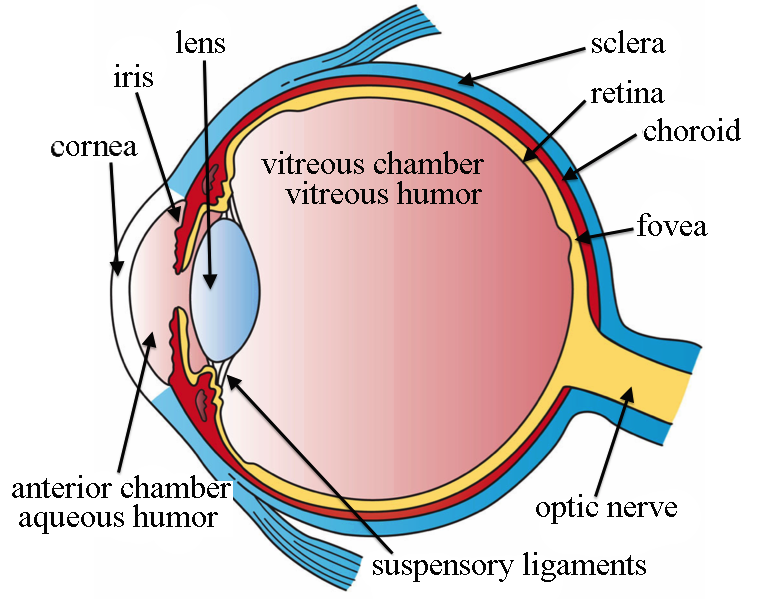Updated on September 24, 2024
What Is the Fovea?


Vision Center is funded by our readers. We may earn commissions if you purchase something via one of our links.
The fovea centralis (fovea) is a small depression at the center of the retina. It provides the sharpest vision in the human eye, also called foveal vision.
The central fovea contains a high concentration of retinal cells called cone photoreceptors. Cone cells help us see colors and fine details. This type of high-acuity vision enables you to perform activities like reading, writing, and examining objects up close.
Even though the fovea centralis spans a very tiny area, it plays a major role in visual acuity (sharpness).

What Is the Function of the Fovea?
The fovea is the area of the retina that provides maximum visual acuity. To see an object with sharp vision, you must focus the image on the fovea centralis.
Foveal vision consists of the central two degrees of your visual field, which is about twice as wide as your thumbnail held at arm’s length. This is why you unconsciously move your head or eyes when reading this sentence — to center the words on the fovea.
Other Parts and Functions of the Human Eye
Other important parts of the eye include:
- The cornea. The clear bulging surface of the eye.
- Sclera. The white part of the eye.
- Conjunctiva. Covers the sclera.
- Pupil. An opening through which light passes into the eye.
- Iris. The colored part that surrounds the pupil.
- The lens of the eye. The clear inner part of the eye that helps with focus.
- Vitreous Humor. The fluid-filled space between the lens and the retina.
- Optic nerve. The bundle of nerve fibers that relays visual information from the retina to the brain for processing.
Anatomy of the Fovea
The fovea centralis is a tiny depression at the center of the macula lutea (macula), which is the center of the human retina. It's about 1.5 mm in diameter and contains about 199,000 cones/mm squared.1
The central pit of the fovea is called the foveola. A unique feature of the foveal pit is the displacement of other retinal cells to create space for cone photoreceptors.
The central fovea contains only cones, and virtually no rods (rods and cones are the two types of photoreceptor cells). Rod photoreceptors are more abundant in the surrounding retina. Foveal cones are thinner and more compact than cone cells in other retinal regions.
The fovea contains no blood vessels. It receives its blood supply from the choroid, which is adjacent to the retinal pigment epithelium.
This high cone density and absence of blood vessels enable the sharp vision provided by the human fovea.
Conditions That May Affect the Fovea
A variety of eye problems can affect the fovea centralis. Without treatment, some may result in vision loss.
Common eye conditions that can affect the fovea include:
Age-Related Macular Degeneration
Age-related macular degeneration affects 11 million people in the U.S. and is the leading cause of vision loss among older adults.6
People with age-related macular degeneration experience a loss of central, sharp vision due to damage in the macula. The fovea is the center of the macula.
Macular Hole
This is a break or tear in the tissue of the macula. Macular holes usually result from age-related changes in your eye. However, it’s not the same as age-related macular degeneration.
Things in your center vision become blurry, wavy, or distorted as the hole forms. As the hole expands, a dark or blind area appears in your central vision. Peripheral vision may remain intact.
Branch Retinal Vein Occlusion (BRVO)
Branch retinal vein occlusion occurs when one of the blood vessels in the retina gets blocked.
Blood and fluid may leak out onto the retina when a vein is blocked, causing macular swelling. This may compromise your central vision. Without a blood supply, cells in the retina and fovea will eventually die.
Choroidal Neovascular Membranes
Choroidal neovascular membranes (CNVM) are new, abnormal blood vessels that form underneath the retina and cause damage. This condition is typically related to advanced wet macular degeneration.
These blood vessels develop in the choroid. They’re able to get past the choroid-retina barrier. This may cause visual loss when they leak or bleed in the retina.
Cytomegalovirus Retinitis
This is a serious infection of the retina caused by cytomegalovirus. It can progress and lead to foveal damage.
Cytomegalovirus retinitis most often affects people with weak immune systems. Symptoms include a slow onset of floaters and blurred vision. This can progress to central vision loss.
Diabetic Retinopathy
This condition can occur in people with diabetes. Uncontrolled high blood sugar levels can damage the blood vessels in the eye, causing them to leak.
The vessels can also become blocked, causing blood flow to stop. Abnormal new vessels may develop. All these conditions affect the ability to see.
Histoplasmosis
Histoplasmosis is an infection of the lung caused by inhaling airborne spores from the fungus type called Histoplasma capsulatum. Doctors believe that, even if it’s mild, the infection might spread to the eye through the bloodstream.
It may cause a dangerous disease known as presumed ocular histoplasmosis syndrome (POHS) if it progresses into the eye.
Macular Edema
This is when fluid builds up in the macula, causing swelling. Macular edema can cause blurry vision and washed-out colors.
Many things can cause macular edema, including age-related macular degeneration, diabetes, and retinitis pigmentosa.
Retinitis Pigmentosa
This is a genetic condition inherited from family. People with retinitis pigmentosa may experience a loss of night vision, peripheral vision, and potentially central vision. They may also have trouble seeing colors.
Retinal Detachment
This is when the retina separates from the back of the eye. Retinal detachment is a medical emergency that requires immediate care.
Early symptoms include floaters, flashing lights, and a shadow or dark curtain over your peripheral vision.
Retinoblastoma
Retinoblastoma is an eye cancer. The cancer begins in the retina and can spread to other parts of the eye. It occurs when the retina's nerve cells become abnormal, increasing in size and quantity.
The cells ultimately join together to create a tumor. Usually, the cells distribute in and around the eye but can spread to other parts of the body. Retinoblastoma typically affects children and can spread aggressively, requiring immediate medical attention.
Stargardt Disease
Also known as juvenile macular dystrophy, this kind of macular degeneration targets and kills the macula's photoreceptor cells.
Unlike age-related macular degeneration, Stargardt disease affects young adults and children. The disease results in central vision loss at an early age.
When to See a Doctor for Fovea Complications
Consult your eye doctor if you have any sudden vision changes or persistent issues with your eyes.
Seek emergency treatment if an eye issue is causing flashes of light or vision loss.
Why Routine Eye Exams Are Important
Routine exams are important because they help your eye doctor detect any issues before they become serious.
During a routine eye exam, your ophthalmologist will check for all common eye issues, such as cataracts, macular degeneration, tears, or detachments.
They'll also assess your visual accuity and advise you on best care practices to keep your eyes healthy.
Treatment Options for Foveal Diseases
Foveal diseases are treated depending on the cause of damage.
Common treatments include:
- Laser surgery. Also known as focal laser treatment, laser surgery stops blood vessels from leaking into the retina if you have diabetic retinopathy.
- Medications. An ophthalmologist may administer medications, such as eye injections. This is common in the treatment of branch retinal vein occlusion (BRVO). Anti-VEGF drugs treat abnormal blood vessels.
- Vitrectomy. This is a surgery used to treat macular holes. It involves replacing the vitreous fluid with a gas bubble to help flatten the hole.
- Supplements. Your eye doctor may prescribe supplements rich in lutein, zeaxanthin, vitamin C, vitamin E, and zinc to slow the progression of macular degeneration.
Summary
The fovea is a tiny depression in the center of the macula, which is the center of the retina. It’s also called the fovea centralis. The macula is responsible for sharp vision, but the fovea has the sharpest vision, also known as foveal vision.
The central fovea has a high concentration of cone cells. This allows you to see colors and fine details. Eye problems affecting the fovea will cause reduced visual acuity and poor color vision.
Different treatment options for foveal damage include laser surgery, vitrectomy, and medications and supplements. Remember to receive routine eye exams and consult your doctor if you notice any worsening eye issues.
Frequently Asked Questions on Fovea
Is the fovea the same as the blind spot?
No. The fovea is the area that provides the highest visual acuity. The blind spot occurs where the optic nerve enters the back of the eye at the optic disc. There are no rods and cones at the optic disc.
What would happen to your vision if the fovea was damaged?
Damage to the fovea would cause a decrease in visual acuity. This will cause trouble seeing colors and fine details.
Can you see without the fovea?
Yes, but not with sharp vision. Certain eye disorders involve the absence of the foveal pit. This leads to poor visual acuity.
In this article
6 sources cited
Updated on September 24, 2024
Updated on September 24, 2024
About Our Contributors
Vincent Ayaga is a medical researcher and seasoned content writer with a bachelor's degree in Medical Microbiology. Specializing in disease investigation, prevention, and control, Vincent is dedicated to raising awareness about visual problems and the latest evidence-based solutions in ophthalmology. He strongly believes in the transformative power of ophthalmic education through research to inform and educate those seeking knowledge in eye health.
Dr. Melody Huang is an optometrist and freelance health writer with a passion for educating people about eye health. With her unique blend of clinical expertise and writing skills, Dr. Huang seeks to guide individuals towards healthier and happier lives. Her interests extend to Eastern medicine and integrative healthcare approaches. Outside of work, she enjoys exploring new skincare products, experimenting with food recipes, and spending time with her adopted cats.

